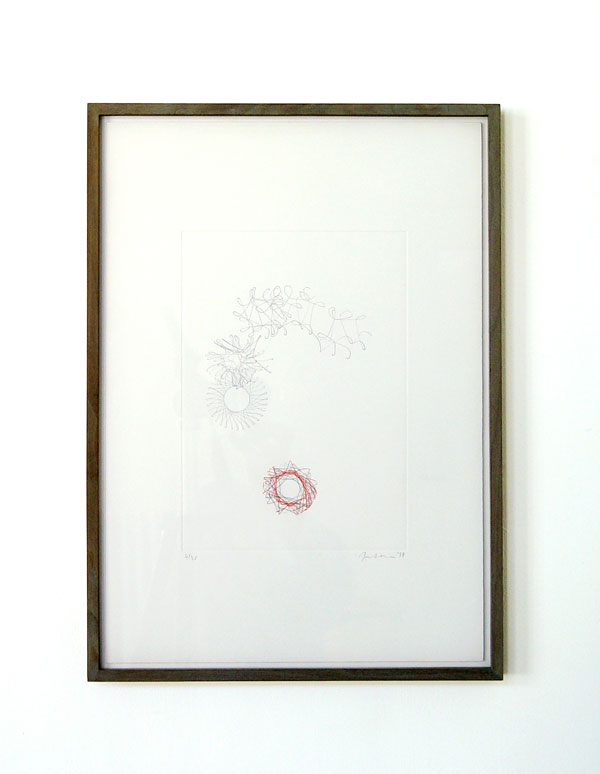11 july 2025, Wouter van den Eijkel
Art Intelligence versus AI at Galerie van Gelder
The day before the conclave, the White House posted an AI-generated image of U.S. President Donald Trump as pope. Dressed in a white chasuble and with a raised index finger, the U.S. president appears to be admonishing us. Galerie Van Gelder took that image as the starting point for the group exhibition Art Intelligence versus AI.
Art or Artificial, it’s only a few letters apart, but it makes a world of difference. Van Gelder contrasts the artificial, functional solutions of AI with the less purposeful propositions made by his artists. The result is a brilliant group exhibition featuring works by young artists like Salim Bayri, Kinball Gunnar Holth, and David Kloosterboer, placed alongside veterans such as Lily van der Stokker, Voebe de Gruyter, and John M. Armleder.
Art Intelligence versus AI is on view at Galerie Van Gelder in Amsterdam until July 28.
“The most shocking thing about it all is that he spread the image himself, not so much that it was made,” says gallery owner Kees van Gelder about the AI-generated image of American President Trump as pope. We see Trump clad in a white chasuble; index finger raised. The image appeared a few days before the conclave, on May 5, on Truth Social, Trump's own social media platform.
“If it were someone else, you might think it was a joke, but here you suspect other intentions.” A model of humility it certainly is not. Even Napoleon, who crowned himself emperor, realized he could not be canonized. Trump here seems to suggest that such posthumous sainthood is indeed in the cards for him.
Versus?
An enlarged version of the image hangs prominently on the back wall of the gallery's front room. “I wanted this work (the image of Trump, ed.) right in the center, because I wanted the artists to have to relate to Trump and also be a little shocked. That was the idea.” By displaying the image so prominently, Van Gelder also legitimizes it as art. Several visitors have already asked Van Gelder who the artist is, seemingly without questioning whether it's a work of art.
The image of Trump as pope got Van Gelder thinking and became the starting point for the group exhibition Art Intelligence versus AI. Art or Artificial, art or artificial—it’s only a few letters apart, but it makes a world of difference. “I thought it would be interesting to present an artificial thinking system alongside an artistic thinking system. The first is functional, the second has no direct utility.”

David Kloosterboer, (No) different ways, 2025, Galerie van Gelder
A whitish start
Van Gelder began the group show with two white works: the altered white t-shirt (No) different ways by David Kloosterboer and a large white canvas with three seahorses by Marijke van Warmerdam. “That gave me a whitish start,” says Van Gelder of the exhibition layout. This allowed to make a gesture with the following works.”
That gesture took the form of a narrowing in the gallery space. Kloosterboer’s t-shirt hangs a meter away from the wall. Directly opposite, also a meter from the other wall, stands a work by Bert McLean, the young British artist who had his first solo show at Van Gelder’s gallery last fall. “Initially I thought it was an illogical spot,” says Van Gelder, “but it turned out to be right. It makes you feel as though you’re being squeezed through a narrow passage—and that’s exactly the feeling I wanted.”

Lily van der Stokker, Worteltje, 1998, Galerie van Gelder
Little Carrot
Before you even pass through the narrowing, you've already encountered two highlights: the spirograph drawing by John Armleder and the light blue plastic cube Worteltje (“Little Carrot”, 1998) by Lily van der Stokker. Worteltje is a sculpture that also serves as a stone for contemplation: you're allowed to sit on it.
Both works were pulled from Van Gelder’s large archive. Both directly engage with the central question of the exhibition’s title: what does intelligence look like when it is not directly functional, like AI? Armleder and Van der Stokker know how to handle that. They are idiosyncratic artists with entirely their own worlds of thought. Armleder used a sheet of paper showing the imprint of an etching plate for his spirograph drawing and numbered the piece, making the viewer wonder if it’s part of an edition. That in itself raises the question: is an edition as valuable as a unique work, or does it feel different?

John M Armleder, Untitled 1998, 34,8 x 49,8 cm (frame: 53,1 x 38,2 cm), colour pencil, lead pencil, Galerie van Gelder
By including the works of the older generation, Van Gelder immediately places those of their younger colleagues within a tradition of highly idiosyncratic artists. The younger generation, whose work is mainly on display in the back room, seems to criticize or entirely abandon the rationality and utility that characterize AI.
Van Gelder chose, among other things, the Free Coffee Test that Salim Bayri conducted with a group of friends in supermarkets around Groningen. While the test provides useless information for anyone outside that region, in a broader sense, Bayri uses this video work to raise questions about our consumerism and, by extension, our obsession with getting the best product for the best price. In the video, the coffee's price is certainly right—but why test something that’s free?
There’s also work by American Rijksakademie alumnus Ian Page. His Tidbits In the Tantamount most resembles a primitive robotic vacuum cleaner. It’s a white cylinder with little brushes at the bottom that merrily sway back and forth as the device moves around. But this vacuum picks up nothing—it simply moves. A pointless device that moves without purpose yet adds a certain sense of joy to the space

Ian Page, Tidbits In the Tantamount, 2018, Galerie van Gelder
